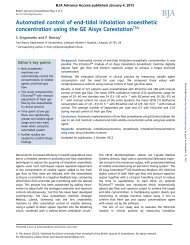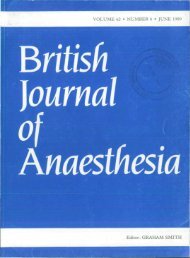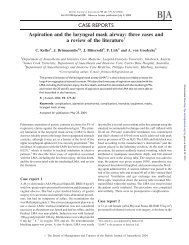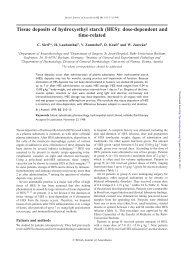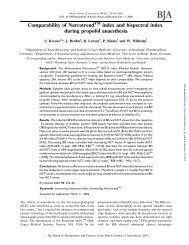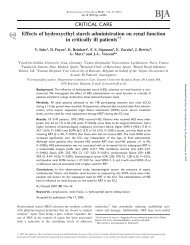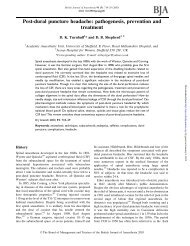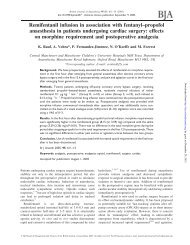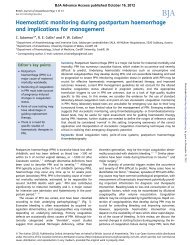Minimal alveolar concentration of sevoflurane for induction of ... - BJA
Minimal alveolar concentration of sevoflurane for induction of ... - BJA
Minimal alveolar concentration of sevoflurane for induction of ... - BJA
Create successful ePaper yourself
Turn your PDF publications into a flip-book with our unique Google optimized e-Paper software.
British Journal <strong>of</strong> Anaesthesia Page 1 <strong>of</strong> 7<br />
doi:10.1093/bja/aet280<br />
<strong>BJA</strong> Advance Access published September 24, 2013<br />
<strong>Minimal</strong> <strong>alveolar</strong> <strong>concentration</strong> <strong>of</strong> sev<strong>of</strong>lurane <strong>for</strong> <strong>induction</strong><br />
<strong>of</strong> isoelectric electroencephalogram in middle-aged adults<br />
B. Niu 1† ,Y.Fang 1† , J. M. Miao 1 ,Y.Yu 2 ,F.Cao 1,4 , H. X. Chen 1 , Z.G. Zhang 3 ,W.Mei 1 * and Y. K. Tian 1 *<br />
1 Department <strong>of</strong> Anaesthesiology and Pain Medicine, Tongji Hospital, 2 Department <strong>of</strong> Otolaryngology-Head and Neck Surgery, Tongji Hospital,<br />
and 3 School <strong>of</strong> Medicine and Health Management, Tongji Medical College, Huazhong University <strong>of</strong> Science and Technology, 13 Hangkong Road,<br />
Wuhan 430030, China<br />
4 Department <strong>of</strong> Neuroscience, Baylor College <strong>of</strong> Medicine, Houston, TX 77054, USA<br />
* Corresponding author. E-mail: wmei@tjh.tjmu.edu.cn (W.M.); yktian@tjh.tjmu.edu.cn (Y.K.T.)<br />
Editor’s key points<br />
† Induction <strong>of</strong> an isoelectric<br />
EEG by anaesthetics has<br />
been implicated in<br />
neuroprotection, and<br />
might be clinically useful<br />
or detrimental in specific<br />
situations.<br />
† The potency <strong>of</strong><br />
sev<strong>of</strong>lurane in producing<br />
an isoelectric EEG was<br />
determined in adult<br />
human subjects be<strong>for</strong>e<br />
surgical incision.<br />
† The minimal <strong>alveolar</strong><br />
<strong>concentration</strong> (MAC) <strong>of</strong><br />
sev<strong>of</strong>lurane <strong>for</strong> isoelectric<br />
EEG was 3.5 vol%, which is<br />
about 2.1 times the MAC<br />
<strong>for</strong> skin incision.<br />
Background. We determined the minimal <strong>alveolar</strong> <strong>concentration</strong> (MAC) <strong>of</strong> sev<strong>of</strong>lurane inducing<br />
an isoelectric EEG in 50% <strong>of</strong> adult subjects (MACie).<br />
Methods. We included 31 middle-aged subjects; 30 subjects finished the study protocol and<br />
received sev<strong>of</strong>lurane at preselected <strong>concentration</strong>s according to a modified Dixon ‘up-anddown’<br />
design starting at 1.7 vol% with 0.2 vol% steps size. General anaesthesia was induced<br />
and maintained with sev<strong>of</strong>lurane; tracheal intubation was facilitated with cisatracurium. After<br />
a period <strong>of</strong> 30 min be<strong>for</strong>e skin incision, the state <strong>of</strong> isoelectric EEG was considered as<br />
significant when a burst suppression ratio <strong>of</strong> 100% lasted <strong>for</strong> .1 min. The haemodynamic<br />
responses to skin incision and the vasopressor requirement to maintain stable haemodynamic<br />
status were also analysed according to the EEG state.<br />
Results. MACie was 3.5% (95% confidence interval, 3.4–3.7%) in middle-aged subjects. When<br />
compared with subjects not in isoelectric EEG state, subjects in isoelectric EEG state received<br />
more phenylephrine to maintain stable haemodynamics (10 <strong>of</strong> 10 compared with 7 <strong>of</strong> 20<br />
subjects, P¼0.001) and experienced less sympathetic responses to skin incision (1 <strong>of</strong> 10<br />
compared with 11 <strong>of</strong> 20 subjects, P¼0.024).<br />
Conclusions. MACie <strong>for</strong> sev<strong>of</strong>lurane was ≏2.1 times MAC <strong>for</strong> immobilization in phenobarbital<br />
premedicated middle-aged adults. Sev<strong>of</strong>lurane-induced isoelectric EEG state is associated<br />
with significant cardiovascular depression but reduced haemodynamic responses to skin<br />
incision.<br />
Keywords: anaesthetics volatile, sev<strong>of</strong>lurane; cardiovascular system, responses; monitoring,<br />
depth <strong>of</strong> anaesthesia; monitoring, electroencephalography<br />
Accepted <strong>for</strong> publication: 7 June 2013<br />
Downloaded from http://bja.ox<strong>for</strong>djournals.org/ by guest on January 21, 2014<br />
<strong>Minimal</strong> <strong>alveolar</strong> <strong>concentration</strong> (MAC) was introduced to<br />
compare the potencies <strong>of</strong> inhalation anaesthetic agents. 1 2<br />
Sev<strong>of</strong>lurane is a commonly used inhalation anaesthesia<br />
agent today. Its effects on motor response (MAC), 3 adrenergic<br />
reflexes (MACBAR), 45 reflex pupillary dilatation (MACpup) 6 to<br />
nociceptive stimulation, and eye opening to verbal command<br />
(MACawake) 7 in 50% <strong>of</strong> subjects have been widely investigated.<br />
However, the relation between <strong>concentration</strong> <strong>of</strong> sev<strong>of</strong>lurane<br />
and different EEG states is relatively unstudied. 8<br />
EEG burst suppression and isoelectric (or persistently suppressed)<br />
EEG, typically associated with states <strong>of</strong> pr<strong>of</strong>ound<br />
brain inactivation, do not appear in normal sleep. 9 They are<br />
frequently observed in deep general anaesthesia, pathological<br />
conditions including hypothermia, hypoxic–ischaemic<br />
trauma, coma, and early infantile encephalopathy. Previous<br />
studies have demonstratedthat burst suppressionorisoelectric<br />
EEG can be purposely induced by anaesthetic agents to protect<br />
the brain during neurosurgery 10 or cardiosurgery. 11 Although<br />
still a controversial issue, low EEG-derived indices might be<br />
associated with adverse outcomes after cardiac and noncardiac<br />
surgery. 12 – 16 Understanding the relation between <strong>concentration</strong>s<br />
<strong>of</strong> volatile anaesthetics and abnormal EEG states<br />
including burst suppression or isoelectric EEG might help practitioners<br />
avoid excessively deep anaesthesia in vulnerable<br />
patients, or achieve transient burst suppression or isoelectric<br />
EEG when desired. Hence, this study aimed to determine the<br />
MAC <strong>of</strong> sev<strong>of</strong>lurane inducing isoelectric EEG (MACie) and burst<br />
suppression EEG (MACbs) in 50% <strong>of</strong> middle-aged adults. In addition,<br />
haemodynamic stability and responses to incision in a<br />
state <strong>of</strong> isoelectric EEG were also analysed.<br />
†<br />
These authors contributed equally to this work.<br />
& The Author [2013]. Published by Ox<strong>for</strong>d University Press on behalf <strong>of</strong> the British Journal <strong>of</strong> Anaesthesia. All rights reserved.<br />
For Permissions, please email: journals.permissions@oup.com
<strong>BJA</strong><br />
Methods<br />
The study was approved by the local Institute’s Ethical Committee<br />
(Huazhong University <strong>of</strong> Science and Technology) and<br />
registered with ClinicalTrials.gov (ref: NCT01662622). After<br />
written in<strong>for</strong>med consent, we enrolled 31 subjects aged<br />
45–65 yr, undergoing upper abdominal surgery using general<br />
anaesthesia from March to May 2012 at Tongji Hospital,<br />
Tongji Medical College, Huazhong University <strong>of</strong> Science and<br />
Technology, Wuhan, China. All participants had an ASA physical<br />
status classification <strong>of</strong> I or II. Patients were excluded from<br />
the study if they had one <strong>of</strong> the following criteria: any neurological<br />
disease or having received central nervous system–<br />
active drugs; a cardiac ejection fraction ,40%; previous<br />
history <strong>of</strong> difficult intubation or anticipated difficult intubation;<br />
daily alcohol consumption; and obesity (defined as a body<br />
mass index .30 kg m –2 ). Those without in<strong>for</strong>med consent<br />
were also excluded.<br />
As premedication, 0.1 g <strong>of</strong> phenobarbital and 0.5 mg <strong>of</strong> atropine<br />
were administered by i.m. injection. After arrival in the<br />
operating theatre, standard monitoring, including electrocardiography,<br />
non-invasive arterial pressure, and pulse oximetry,<br />
was established. The i.v. infusion rate <strong>of</strong> lactated Ringer’s injection<br />
was 15 ml kg 21 h 21 via an 18 G venous catheter. A neuromuscular<br />
monitor (TOF-watch SX; Organon, Dublin, Ireland)<br />
was placed over the ulnar nerve at the wrist.<br />
Electrical activity <strong>of</strong> the brain was measured and recorded<br />
with a Narcotrend Monitor (unprocessed EEG) and S/5 Compact<br />
Anaesthesia Monitor [burst suppression ratio (BSR)].<br />
Sensors <strong>of</strong> the Narcotrend Monitor (MonitorTechnik, Bad Bramstedt,<br />
Germany, version 4.0) and Entropy Module (S/5 Compact<br />
Anaesthesia Monitor, Datex-Ohmeda, Helsinki, Finland) were<br />
attachedto the <strong>for</strong>ehead <strong>of</strong> each subject according to the manufacturer’s<br />
recommendation. Impedances were measured <strong>for</strong><br />
each set <strong>of</strong> electrodes to ensure adequate electrode contact<br />
defined as 6 kV <strong>for</strong> the Narcotrend Monitor and 7.5 kV <strong>for</strong> the<br />
Entropy Module. To calculate BSR, suppression is defined as<br />
periods .0.5 s during which EEG voltage is ,5 mV. Time in a<br />
suppressed state is measured and BSR is reported as the fraction<br />
<strong>of</strong> the epoch during which the EEG is suppressed. BSR is<br />
averaged over at least 15 epochs (60 s). The presence <strong>of</strong> burst<br />
suppression was defined as BSR .0. 17 A BSR <strong>of</strong> 100% implies<br />
isoelectric EEG.<br />
General anaesthesia was induced by tidal volume breathing<br />
<strong>of</strong> 8% sev<strong>of</strong>lurane in 100% oxygen at 6 litre min 21 with<br />
a semi-closed face mask. Cisatracurium 0.15 mg kg 21 was<br />
administered after loss <strong>of</strong> the lash reflex, 18 with manual ventilation<br />
until the amplitude <strong>of</strong> T1 decreased to zero. Tracheal<br />
intubation was per<strong>for</strong>med and switched to mechanical ventilation<br />
with a fresh gas flow <strong>of</strong> 2 litre min 21 . Oxygen, carbon<br />
dioxide, and sev<strong>of</strong>lurane were sampled with a 19 G tube connected<br />
to the distal end <strong>of</strong> the tracheal catheter. Gas <strong>concentration</strong><br />
and partial pressure were analysed by a gas analyser<br />
(S/5 Compact Anaesthesia Monitor) with a sample flow rate<br />
<strong>of</strong> 200 ml min 21 . The end-tidal partial pressure <strong>of</strong> carbon<br />
dioxide was maintained at 4.7 kPa. An oesophageal temperature<br />
probe was inserted and a warming unit was used if<br />
Niu et al.<br />
necessary to maintain 36.5 to 37.58C. Surgery started at<br />
least 30 min after inhalation <strong>induction</strong>, so that the determined<br />
sev<strong>of</strong>lurane <strong>concentration</strong> was stable <strong>for</strong> at least<br />
15 min and the difference <strong>of</strong> inspired and end-tidal <strong>concentration</strong>s<br />
was ,10%. 4 A cuff-based continuous arterial pressure<br />
monitor was used; an audible alarm was set to indicate<br />
mean arterial pressure (MAP) reduction <strong>of</strong> .20% <strong>of</strong> baseline<br />
values. Phenylephrine 0.1 mg was administered i.v. if necessary<br />
to maintain MAP. Neither Entropy nor Narcotrend<br />
alarms were set.<br />
MAC was determined using the Dixon up-and-down method.<br />
To avoid awareness, the first subject received end-tidal<br />
sev<strong>of</strong>lurane <strong>concentration</strong> <strong>of</strong> 1.7% (1 MAC). As shown in<br />
Figure 1, the presence or absence <strong>of</strong> isoelectric EEG <strong>of</strong> the previous<br />
subject determined the end-tidal sev<strong>of</strong>lurane <strong>concentration</strong><br />
<strong>of</strong> the following subject. End-tidal <strong>concentration</strong> <strong>of</strong><br />
sev<strong>of</strong>lurane <strong>for</strong> the next subject was decreased by 0.2% (isoelectric<br />
EEG) or increased by 0.2% (non-isoelectric EEG). A<br />
crossover response was defined as the consecutive inclusion<br />
<strong>of</strong> a subject who presented isoelectric EEG, followed by<br />
another who did not. The value <strong>of</strong> a pair was the average <strong>of</strong><br />
the end-tidal <strong>concentration</strong> used <strong>for</strong> the two subjects <strong>of</strong> this<br />
pair. The MACie was determined by averaging the values <strong>of</strong><br />
six consecutive pairs. For each subject, a 30 min interval was<br />
given to allow equilibration between arterial and brain tensions.<br />
2 The isoelectric EEG was considered as significant<br />
when the isoelectric state lasted .1 min. 19 The maximal BSR<br />
was recorded if isoelectric EEG was not reached. Then, the endtidal<br />
<strong>concentration</strong> <strong>of</strong> sev<strong>of</strong>lurane was maintained until 3 min<br />
after incision. Heart rate (HR) and MAP were recorded at 2 and 1<br />
min be<strong>for</strong>e skin incision, and then at 3 min after surgical incision.<br />
The pre-incision value was defined as the mean value <strong>of</strong><br />
the 2 and 1 min be<strong>for</strong>e skin incision. Adrenergic reflexes (an increase<br />
in either HR or MAP .15% above the pre-incision<br />
values) 5 cases were counted.<br />
Statistical analysis<br />
Patient characteristic data were collected and presented as<br />
mean (SD) or as number (%) where appropriate. The MACie<br />
was calculated as the mean <strong>of</strong> six independent crossovers <strong>of</strong><br />
end-tidal sev<strong>of</strong>lurane <strong>concentration</strong> as shown in Figure 3.<br />
Up-and-down sequences were analysed by the probit test<br />
(SPSS <strong>for</strong> Windows 12.0; SPSS, Inc., Chicago, IL, USA), which<br />
enabled MACie and MACbs with 95% confidence limits <strong>of</strong> the<br />
mean to be derived. 20 Data were also analysed with logistic<br />
regression <strong>for</strong> the probability <strong>of</strong> isoelectric EEG and burst suppression<br />
vs end-tidal <strong>concentration</strong>, the maximum-likelihood<br />
estimation, and goodness-<strong>of</strong>-fit.<br />
Subjects were divided into an isoelectric EEG (ie+) group<br />
and a non-isoelectric EEG (ie2) group. The frequency <strong>of</strong><br />
phenylephrine injection and incidence <strong>of</strong> positive adrenergic<br />
reflexes were compared between groups by two-tailed<br />
Fisher’s exact test. Numerical data were analysed by Student’s<br />
t-test or the Mann–Whitney U-tests where appropriate.<br />
P-values <strong>of</strong> ,0.05 were considered statistically significant.<br />
Downloaded from http://bja.ox<strong>for</strong>djournals.org/ by guest on January 21, 2014<br />
Page 2 <strong>of</strong> 7
MAC <strong>of</strong> sev<strong>of</strong>lurane <strong>for</strong> isoelectric EEG<br />
<strong>BJA</strong><br />
Assessed <strong>for</strong> eligibility (n=31)<br />
Ineligible (n=0)<br />
Eligible but not recruited (n=0)<br />
Recruited (n=31)<br />
Allocated to end-tidal <strong>concentration</strong> <strong>of</strong> 1.7%<br />
End-tidal <strong>concentration</strong><br />
<strong>of</strong> the next patient was<br />
decreased by 0.2%<br />
Yes<br />
Isoelectric EEG<br />
No<br />
6 crossovers<br />
<strong>of</strong> responses<br />
Yes<br />
No<br />
Analysed (n=30)<br />
Excluded <strong>for</strong> severe hypotension (n=1)<br />
End-tidal <strong>concentration</strong><br />
<strong>of</strong> the next patient was<br />
increased by 0.2%<br />
Downloaded from http://bja.ox<strong>for</strong>djournals.org/ by guest on January 21, 2014<br />
Fig 1 Flow chart <strong>for</strong> the Dixon up-and-down method.<br />
Results<br />
As shown in Figure 1, <strong>of</strong> 40 patients assessed <strong>for</strong> eligibility, 31<br />
were screened and subsequently enrolled. One subject was<br />
excluded because <strong>of</strong> severe hypotension during the equilibration<br />
period. Data analysis was per<strong>for</strong>med on 30 ASA I–II subjects<br />
who finished the study.<br />
Grouped patient characteristic data are presented in Table 1.<br />
There were more subjects in the ie2 group than in the ie+<br />
group (20 compared with 10) because <strong>of</strong> the experimental<br />
design. However, the groups were similar with respect to<br />
other characteristics. In addition, the three surgeons who<br />
were involved in the study were equally distributed between<br />
the two groups, and the surgical incisions were <strong>of</strong> similar<br />
type and length.<br />
Figure 2 shows the Narcotrend index change over the course<br />
<strong>of</strong> anaesthesia from Subject 15, who received end-tidal sev<strong>of</strong>lurane<br />
<strong>concentration</strong> <strong>of</strong> 3.7% and showed a representative<br />
curve <strong>of</strong> the ie+ group.<br />
MAC calculation<br />
Figure 3 shows the up-and-down progression. MACie determined<br />
by the Dixon method was 3.5 (0.1)%. As the <strong>concentration</strong><br />
<strong>of</strong> sev<strong>of</strong>lurane increased, suppression <strong>of</strong> the EEG was not<br />
all or none. Figure 4 shows the maximal BSR <strong>of</strong> each subject<br />
obtained in the period be<strong>for</strong>e skin incision. Twenty-one <strong>of</strong> 30<br />
subjects displayed burst suppression EEG.<br />
Figure 5 showsthe dose–response curve <strong>of</strong> the probability<strong>of</strong><br />
isoelectric EEG (Fig. 5A) and burst suppression (Fig. 5B). The 50%<br />
Page 3 <strong>of</strong> 7
<strong>BJA</strong><br />
Niu et al.<br />
Table 1 Subject characteristics. Data are presented as mean (SD),<br />
mean (range), or number (%). Temperature and PE ′ CO 2<br />
were<br />
recorded 2 min be<strong>for</strong>e incision. Time interval, time from <strong>induction</strong><br />
to incision; fluids administered was calculated from entering the<br />
room to incision<br />
ie1 (n510)<br />
ie2 (n520)<br />
Age (yr) 56 (46–65) 55 (45–64)<br />
Male gender [n (%)] 5 (50) 12 (60)<br />
Height (cm) 164 (8) 162 (8)<br />
Weight (kg) 57 (11) 61 (11)<br />
Temperature (8C) 36.6 (0.5) 36.4 (0.3)<br />
Time interval (min) 33 (3) 32 (2)<br />
Fluids administered (ml) 745 (26) 757 (30)<br />
PE ′ CO 2<br />
(kPa) 4.8 (0.2) 5.0 (0.2)<br />
A<br />
B<br />
C<br />
D<br />
E<br />
F<br />
1 2<br />
3 4 5 6 1 Induction<br />
2 Intubation<br />
3 EEG burst suppression<br />
4 Isoelectric EEG<br />
5 Incision<br />
6 End<br />
09:00 10:00 11:00<br />
Fig 2 Narcotrend index change over the course <strong>of</strong> anaesthesia <strong>for</strong><br />
Subject 15.<br />
effective dose <strong>for</strong> isoelectric EEG was 3.5% sev<strong>of</strong>lurane [95%<br />
confidence interval (CI), 3.4–3.7%] and 95% effective dose<br />
was 3.7% (3.6–4.9%). The calculated probabilities <strong>of</strong> the occurrence<br />
<strong>of</strong> isoelectric EEG <strong>for</strong> other quantiles are detailed in<br />
Table 2. Maximum-likelihood estimation showed a P¼1 and<br />
goodness-<strong>of</strong>-fit x 2 ¼0.533.<br />
The 50% effective dose <strong>for</strong> burst suppression EEG was<br />
3.0% (2.1–3.3%). Maximum-likelihood estimation showed<br />
a P¼0.922 and goodness-<strong>of</strong>-fit x 2 ¼3.841.<br />
Vasopressor requirement<br />
MAP was maintained by repeated administration <strong>of</strong> phenylephrine.<br />
When compared with the ie2 group (7 <strong>of</strong> 20), all subjects<br />
in the ie+ group (10 <strong>of</strong> 10) needed phenylephrine<br />
(Table 3); the difference was significant (P¼0.001).<br />
Adrenergic response to incision<br />
Only 1 <strong>of</strong> 10 ie+ subjects showed an increase <strong>of</strong> .15% in HR<br />
or MAP, whereas 11 <strong>of</strong> 20 ie2 subjects showed an increase<br />
(Table 3). Compared with ie2 subjects, ie+ subjects experienced<br />
less adrenergic responses to incision (P¼0.024).<br />
Discussion<br />
The MACie <strong>of</strong> sev<strong>of</strong>lurane in 100% oxygen was 3.5% (2.1 times<br />
MAC) in middle-aged adults premedicated with phenobarbital.<br />
The crossover responses observed were markedly stable<br />
between 3.3% (all five subjects ie2) and 3.7% (all six subjects<br />
ie+), suggesting high reliability <strong>of</strong> the target sev<strong>of</strong>lurane<br />
<strong>concentration</strong>.<br />
Based on the MAC <strong>for</strong> middle-aged subjects <strong>of</strong> 1.7%, 21 the<br />
MACie was ≏2.1 MAC, which was close to MACBAR (2.2<br />
MAC). 22 The EEG recorded by the Entropy Module demonstrates<br />
cortical activity, 23 while the autonomic cardiovascular centres<br />
are located in the medulla. So MACBAR and MACie represent<br />
the sensitivity <strong>of</strong> different brain structures to sev<strong>of</strong>lurane. Previous<br />
studies showed that burst suppression induced by<br />
Downloaded from http://bja.ox<strong>for</strong>djournals.org/ by guest on January 21, 2014<br />
End-tidal sev<strong>of</strong>lurane %<br />
3.9<br />
3.7<br />
3.5<br />
3.3<br />
3.1<br />
2.9<br />
2.7<br />
2.5<br />
2.3<br />
2.1<br />
1.9<br />
1.7<br />
ie–<br />
ie+<br />
Crossover<br />
MACie<br />
1 2 3 4 5 6 7 8 9 101112131415161718192021222324252627282930<br />
Patients<br />
Fig 3 Response <strong>of</strong> each subject to predetermined end-tidal sev<strong>of</strong>lurane <strong>concentration</strong>s. The points <strong>of</strong> ie+ and ie2 responses plus the broken line<br />
show six crossovers <strong>of</strong> responses. The horizontal line represents the MACie value.<br />
Page 4 <strong>of</strong> 7
MAC <strong>of</strong> sev<strong>of</strong>lurane <strong>for</strong> isoelectric EEG<br />
<strong>BJA</strong><br />
100<br />
80<br />
60<br />
40<br />
20<br />
0<br />
1 2 3 4 5 6 7 8 9 101112131415161718192021222324252627282930<br />
Age (yr) 61 57 56 60 64 56 54 48 58 48 55 48 54 46 63 55 45 58 61 65 56 56 51 59 57 52 46 51 57 57<br />
FE sevo (%) 1.7 1.9 2.1 2.3 2.5 2.7 2.9 3.1 3.3 3.5 3.7 3.5 3.3 3.5 3.7 3.5 3.3 3.5 3.7 3.5 3.3 3.5 3.7 3.5 3.3 3.5 3.7 3.5 3.7 3.5<br />
Burst suppression ratio (%)<br />
Fig 4 Maximal BSR <strong>of</strong> each subject in per cent. BSR between 0% and 100% shown by bars, 0, no burst suppression EEG; 100, isoelectric EEG. The age<br />
and end-tidal <strong>concentration</strong> <strong>of</strong> sev<strong>of</strong>lurane are indicated.<br />
A 100<br />
90<br />
80<br />
70<br />
60<br />
50<br />
40<br />
30<br />
20<br />
10<br />
0<br />
3.3 3.4 3.5 3.6 3.7 3.8<br />
End-tidal sev<strong>of</strong>lurane <strong>concentration</strong> (%)<br />
B 100<br />
90<br />
80<br />
70<br />
60<br />
50<br />
40<br />
30<br />
20<br />
10<br />
0<br />
2.2 2.4 2.6 2.8 3.0 3.2 3.4 3.6 3.8 4.0<br />
End-tidal sev<strong>of</strong>lurane <strong>concentration</strong> (%)<br />
Probability <strong>of</strong> isoelectric EEG (%)<br />
Probability <strong>of</strong> burst suppression (%)<br />
Fig 5 (A) The dose–response curve from the probit analyses <strong>of</strong> endtidal<br />
sev<strong>of</strong>lurane <strong>concentration</strong>s and the probability <strong>of</strong> isoelectric<br />
EEG (MACie). MACie is 3.5 vol% (3.4–3.7 vol%). (B) The dose–<br />
response curve from the probit analyses <strong>of</strong> end-tidal sev<strong>of</strong>lurane<br />
<strong>concentration</strong>s and the probability <strong>of</strong> the presence <strong>of</strong> burst<br />
suppression (MACbs). MACbs is 3.0 vol% (2.1–3.3 vol%).<br />
Table 2 Calculated probabilities <strong>of</strong> isoelectric EEG<br />
Probability<br />
End-tidal sev<strong>of</strong>lurane<br />
<strong>concentration</strong> (vol%)<br />
95% CI<br />
0.01 3.28 2.24, 3.40<br />
0.05 3.35 2.56, 3.44<br />
0.10 3.39 2.75, 3.47<br />
0.20 3.43 2.98, 3.50<br />
0.30 3.47 3.16, 3.54<br />
0.40 3.49 3.30, 3.59<br />
0.50 3.52 3.40, 3.67<br />
0.60 3.55 3.46, 3.81<br />
0.70 3.58 3.50, 3.99<br />
0.80 3.61 3.54, 4.22<br />
0.90 3.66 3.57, 4.59<br />
0.95 3.70 3.60, 4.93<br />
0.99 3.78 3.64, 5.62<br />
sev<strong>of</strong>lurane was synchronous over the whole cortex, but was<br />
not synchronous in phylogenetically different brain areas:<br />
phylogenetically older areas were more resistant to EEG suppression<br />
than the neocortex. 24 25 In our study, the value <strong>of</strong><br />
MACie was close to the MACBAR, which could be explained by<br />
the approximate requirement <strong>of</strong> sev<strong>of</strong>lurane to suppress electric<br />
activity in the cortex and medulla. Accordingly, our results<br />
demonstrate that the state <strong>of</strong> isoelectric EEG allows less adrenergic<br />
responses to nociceptive stimulation compared with the<br />
state <strong>of</strong> non-isoelectric EEG. Subjects in the state <strong>of</strong> isoelectric<br />
EEG needed more vasopressor to maintain haemodynamic<br />
stability in the absence <strong>of</strong> surgical stimulation. The synchronous<br />
inhibition <strong>of</strong> HR and cortical electrical activity had been<br />
demonstrated in humans receiving is<strong>of</strong>lurane and enflurane<br />
anaesthesia. 26 27 Provided MACie is equal (or close) to<br />
MACBAR, we may intentionally produce isoelectric EEG targeted<br />
to blunt autonomic reflexes in indicated patients.<br />
However, medications such as opioid and benzodiazepine<br />
Page 5 <strong>of</strong> 7<br />
Downloaded from http://bja.ox<strong>for</strong>djournals.org/ by guest on January 21, 2014
<strong>BJA</strong><br />
Niu et al.<br />
Table 3 Haemodynamic parameters. Data are presented as mean (SD) or number (%). HR, heart rate; MAP, mean arterial pressure. HR and MAP<br />
were recorded on entering the room, 2 min be<strong>for</strong>e, and 3 min after skin incision, respectively. NS, not significant<br />
ie1 (n510) ie2 (n520) P-value<br />
Preoperative MAP (mm Hg) 92 (7) 95 (6) NS<br />
Pre-incision MAP (mm Hg) 94 (7) 89 (7) NS<br />
Post-incision MAP (mm Hg) 99 (14) 100 (11)<br />
Preoperative HR (beats min 21 ) 72 (9) 69 (7) NS<br />
Pre-incision HR (beats min 21 ) 82 (9) 80 (5) NS<br />
Post-incision HR (beats min 21 ) 90 (10) 90 (9)<br />
Phenylephrine injection [n (%)] 10 (100) 7 (35) 0.001<br />
MAP or HR increase .15% [n (%)] 1 (10) 11 (55) 0.024<br />
might differentially affect MACBAR and MACie, an interesting<br />
direction <strong>for</strong> further studies.<br />
Preliminary studies <strong>of</strong> neuroprotection suggested that<br />
anaesthetic-associated protection might be mediated by a<br />
reduced metabolic demand, 28 such that complete suppression<br />
<strong>of</strong> cortical electric activity would lead to maximal neuroprotection.<br />
But, most <strong>of</strong> the evidence was based on animal experiments<br />
29 since it was hard to do similar experiments with<br />
human subjects. Doyle and Matta 10 showed that isoelectric<br />
EEG gave more metabolic suppression than 0% and 50% BSR<br />
in 11 patients undergoing general anaesthesia. Although still<br />
controversial, 15 a growing body <strong>of</strong> preliminary evidence associates<br />
low BIS values and intermediate-term mortality in both<br />
cardiac and non-cardiac surgical patients. 12 – 14 16 It is not<br />
clear whether the deep anaesthesia-associated adverse outcomes<br />
are different between cardiac and non-cardiac surgical<br />
patients, or whether the correlation is causal. Our study was<br />
not to analyse the cerebral protective or impairing effects <strong>of</strong><br />
a certain anaesthesia depth, but to find a basis on which a<br />
further study can be carried out.<br />
This trial has some important limitations. All subjects were<br />
hospitalized middle-aged adults, not healthy volunteers,<br />
which might lead to Berkson’s bias. Elderly and critically ill<br />
patients, who are more likely to have serious complications<br />
under excessively deep anaesthesia, were excluded <strong>for</strong> safety<br />
reasons. Such a cohort needs to be included in further studies<br />
to generalize the estimation <strong>of</strong> MACie to a broader population.<br />
We arbitrarily started at 1.7% (1 MAC) with a step size <strong>of</strong> 0.2%<br />
(0.1 MAC) according to previous studies. 6 As the sev<strong>of</strong>lurane<br />
vaporizer output covers a small range from 0% to 8%, a<br />
linear rather than logarithmic scale was used. 56 When using<br />
the modified Dixon up-and-down method, sample size determination<br />
is relatively speculative. In order to balance the interest<br />
<strong>of</strong> accurate MACie estimation and variability estimation,<br />
we terminated our experiment after six crossovers were<br />
observed to minimize the potential bias. 20 The primary focus<br />
<strong>of</strong> the present study was to determine the <strong>concentration</strong> <strong>of</strong><br />
sev<strong>of</strong>lurane inducing isoelectric EEG in 50% <strong>of</strong> subjects<br />
(MACie); values <strong>for</strong> other quantiles can be estimated with<br />
the probit model, but these estimates might not be reliable<br />
at both tails <strong>of</strong> the tolerance distribution. 30 Cerebral blood<br />
flow and cerebral oxygen metabolism rate might have<br />
Page 6 <strong>of</strong> 7<br />
influenced the state <strong>of</strong> isoelectric EEG, but we were unable to<br />
collect these data. Volatile anaesthetic <strong>induction</strong> and maintenance<br />
with sev<strong>of</strong>lurane avoided potential interactions with<br />
other anaesthetics that might confound MACie estimation.<br />
Patients with known factors that might confound MAC were<br />
excluded, and the experiment was strictly controlled to avoid<br />
possible confounds such as hypotension, hypothermia, and<br />
hyperthermia. Several factors, including age and i.v. anaesthetics,<br />
might change the value <strong>of</strong> MACie <strong>of</strong> sev<strong>of</strong>lurane,<br />
which should be studied in the next step. All subjects received<br />
a single dose <strong>of</strong> phenobarbital as premedication according to<br />
local standards, which could affect the MACie determination;<br />
further work is needed to clarify this issue, and to determine<br />
the MACie <strong>for</strong> other currently used volatile agents.<br />
In summary, the MACie <strong>of</strong> sev<strong>of</strong>lurane in middle-aged<br />
adults premedicated with phenobarbital was 3.5 vol%. The<br />
sev<strong>of</strong>lurane-induced isoelectric EEG state is associated with<br />
significant cardiovascular depression but reduced haemodynamic<br />
responses to skin incision. These data might be<br />
useful in avoiding excessive depth <strong>of</strong> anaesthesia in vulnerable<br />
patients, or achieving transient burst suppression or isoelectric<br />
EEG when desired.<br />
Authors’ contributions<br />
B.N., W.M., and Y.K.T. had full access to all data in the study<br />
and take responsibility <strong>for</strong> data integrity and the accuracy <strong>of</strong><br />
the data analysis. B.N., W.M., and Y.K.T.: study concept and<br />
design. B.N., Y.F., J.M.M., H.X.C., and Y.Y.: acquisition <strong>of</strong> data.<br />
W.M. and Y.K.T.: analysis and interpretation <strong>of</strong> data. B.N. and<br />
Y.F.: draft <strong>of</strong> the manuscript. F.C., W.M., and Y.K.T.: critical revision<br />
<strong>of</strong> the manuscript <strong>for</strong> important intellectual content.<br />
Z.G.Z.: statistical analysis. W.M. and Y.K.T.: obtain funding.<br />
W.M. and Y.K.T.: study supervision.<br />
Acknowledgement<br />
We gratefully acknowledge the expertise <strong>of</strong> Ms Amber Chen<br />
(Project Intern, Department <strong>of</strong> Neuroscience, Baylor College<br />
<strong>of</strong> Medicine) in the preparation <strong>of</strong> the manuscript.<br />
Declaration <strong>of</strong> interest<br />
None declared.<br />
Downloaded from http://bja.ox<strong>for</strong>djournals.org/ by guest on January 21, 2014
MAC <strong>of</strong> sev<strong>of</strong>lurane <strong>for</strong> isoelectric EEG<br />
<strong>BJA</strong><br />
Funding<br />
This work was supported by grants from the National Natural<br />
Science Foundation <strong>of</strong> P.R. China (no. 31000417 to W.M. and<br />
no. 81070890 and no. 30872441 to Y.K.T.) and 2010 Clinical<br />
Key Disciplines grant from the Ministry <strong>of</strong> Health <strong>of</strong> PR China.<br />
References<br />
1 Merkel G, Eger EI II. A comparative study <strong>of</strong> halothane and halopropane<br />
anesthesia including method <strong>for</strong> determining equipotency.<br />
Anesthesiology 1963; 24: 346–57<br />
2 Eger EI II, Saidman LJ, Brandstater B. Minimum <strong>alveolar</strong> anesthetic<br />
<strong>concentration</strong>: a standard <strong>of</strong> anesthetic potency. Anesthesiology<br />
1965; 26: 756–63<br />
3 Katoh T, Ikeda K. The minimum <strong>alveolar</strong> <strong>concentration</strong> (MAC) <strong>of</strong><br />
sev<strong>of</strong>lurane in humans. Anesthesiology 1987; 66: 301–3<br />
4 Ura T, Higuchi H, Taoda M, Sato T. Minimum <strong>alveolar</strong> <strong>concentration</strong><br />
<strong>of</strong> sev<strong>of</strong>lurane that blocks the adrenergic response to surgical incision<br />
in women: MACBAR. Eur J Anaesthesiol 1999; 16: 176–81<br />
5 Albertin A, Casati A, Bergonzi P, Fano G, Torri G. Effects <strong>of</strong> two targetcontrolled<br />
<strong>concentration</strong>s (1 and 3 ng/ml) <strong>of</strong> remifentanil on<br />
MAC(BAR) <strong>of</strong> sev<strong>of</strong>lurane. Anesthesiology 2004; 100: 255–9<br />
6 Bourgeois E, Sabourdin N, Louvet N, Donette FX, Guye ML,<br />
Constant I. <strong>Minimal</strong> <strong>alveolar</strong><strong>concentration</strong> <strong>of</strong> sev<strong>of</strong>lurane inhibiting<br />
the reflex pupillary dilatation after noxious stimulation in children<br />
and young adults. Br J Anaesth 2012; 108: 648–54<br />
7 Stoelting RK, Longnecker DE, Eger EI II. Minimum <strong>alveolar</strong> <strong>concentration</strong>s<br />
in man on awakening from methoxyflurane, halothane,<br />
ether and fluroxene anesthesia: MAC awake. Anesthesiology<br />
1970; 33:5–9<br />
8 Whitlock EL, Villafranca AJ, Lin N, et al. Relationship between<br />
bispectral index values and volatile anesthetic <strong>concentration</strong>s<br />
during the maintenance phase <strong>of</strong> anesthesia in the B-Unaware<br />
trial. Anesthesiology 2011; 115: 1209–18<br />
9 Brown EN, Lydic R, Schiff ND. General anesthesia, sleep, and coma.<br />
N Engl J Med 2010; 363: 2638–50<br />
10 Doyle PW, Matta BF. Burst suppression or isoelectric encephalogram<br />
<strong>for</strong> cerebral protection: evidence from metabolic suppression<br />
studies. Br J Anaesth 1999; 83: 580–4<br />
11 Reinsfelt B, Westerlind A, Houltz E, Ederberg S, Elam M, Ricksten SE.<br />
The effects <strong>of</strong> is<strong>of</strong>lurane-induced electroencephalographic burst<br />
suppression on cerebral blood flow velocityand cerebral oxygen extraction<br />
during cardiopulmonary bypass. Anesth Analg 2003; 97:<br />
1246–50<br />
12 Leslie K, Myles PS, Forbes A, Chan MT. The effect <strong>of</strong> bispectral index<br />
monitoring on long-term survival in the B-aware trial. Anesth Analg<br />
2010; 110: 816–22<br />
13 Kertai MD, Pal N, Palanca BJ, et al. Association <strong>of</strong> perioperative risk<br />
factors and cumulative duration <strong>of</strong> low bispectral index with<br />
intermediate-term mortality after cardiac surgery in the<br />
B-Unaware Trial. Anesthesiology 2010; 112: 1116–27<br />
14 Lindholm ML, Traff S, Granath F, et al. Mortality within 2 years after<br />
surgery in relation to low intraoperative bispectral index values and<br />
preexisting malignant disease. Anesth Analg 2009; 108: 508–12<br />
15 Kertai MD, Palanca BJ, Pal N, et al. Bispectral index monitoring, duration<br />
<strong>of</strong> bispectral index below 45, patient risk factors, and<br />
intermediate-term mortality after noncardiac surgery in the<br />
B-Unaware Trial. Anesthesiology 2011; 114: 545–56<br />
16 Monk TG, Saini V, Weldon BC, Sigl JC. Anesthetic management and<br />
one-year mortality after noncardiac surgery. Anesth Analg 2005;<br />
100:4–10<br />
17 Watson PL, Shintani AK, Tyson R, Pandharipande PP, Pun BT, Ely EW.<br />
Presence <strong>of</strong> electroencephalogram burst suppression in sedated,<br />
critically ill patients is associated with increased mortality. Crit<br />
Care Med 2008; 36: 3171–7<br />
18 Wadhwa A, Durrani J, Sengupta P, Doufas AG, Sessler DI. Women<br />
have the same desflurane minimum <strong>alveolar</strong> <strong>concentration</strong> as<br />
men: a prospective study. Anesthesiology 2003; 99: 1062–5<br />
19 Rampil IJ. A primer <strong>for</strong> EEG signal processing in anesthesia. Anesthesiology<br />
1998; 89: 980–1002<br />
20 Paul M, Fisher DM. Are estimates <strong>of</strong> MAC reliable? Anesthesiology<br />
2001; 95: 1362–70<br />
21 Nickalls RW, Mapleson WW. Age-related iso-MAC charts <strong>for</strong> is<strong>of</strong>lurane,<br />
sev<strong>of</strong>lurane and desflurane in man. Br J Anaesth 2003; 91:<br />
170–4<br />
22 Katoh T, KobayashiS, Suzuki A, Iwamoto T, Bito H, Ikeda K. The effect<br />
<strong>of</strong> fentanyl on sev<strong>of</strong>lurane requirements <strong>for</strong> somatic and sympathetic<br />
responses to surgical incision. Anesthesiology 1999; 90:<br />
398–405<br />
23 Viertio-Oja H, Maja V, Sarkela M, et al. Description <strong>of</strong> the Entropy algorithm<br />
as applied in the Datex-Ohmeda S/5 Entropy Module. Acta<br />
Anaesthesiol Scand 2004; 48: 154–61<br />
24 Sonkajarvi E, Alahuhta S, Suominen K, et al. Topographic electroencephalogram<br />
in children during mask <strong>induction</strong> <strong>of</strong> anaesthesia<br />
with sev<strong>of</strong>lurane. Acta Anaesthesiol Scand 2009; 53:77–84<br />
25 Osawa M, Shingu K, Murakawa M, et al. Effects <strong>of</strong> sev<strong>of</strong>lurane on<br />
central nervous system electrical activity in cats. Anesth Analg<br />
1994; 79:52–7<br />
26 Jantti V, Yli-Hankala A. Correlation <strong>of</strong> instantaneous heart rate and<br />
EEG suppression during enflurane anaesthesia: synchronous inhibition<br />
<strong>of</strong> heart rate and cortical electrical activity? Electroencephalogr<br />
Clin Neurophysiol 1990; 76: 476–9<br />
27 Yli-Hankala A, Jantti V. EEG burst-suppression pattern correlates<br />
with the instantaneous heart rate under is<strong>of</strong>lurane anaesthesia.<br />
Acta Anaesthesiol Scand 1990; 34: 665–8<br />
28 Schifilliti D, Grasso G, Conti A, Fodale V. Anaesthetic-related neuroprotection:<br />
intravenous or inhalational agents? CNS Drugs 2010; 24:<br />
893–907<br />
29 Michenfelder JD. The interdependency <strong>of</strong> cerebral functional and<br />
metabolic effects following massive doses <strong>of</strong> thiopental in the<br />
dog. Anesthesiology 1974; 41: 231–6<br />
30 Pace NL, Stylianou MP. Advances in and limitations <strong>of</strong> up-and-down<br />
methodology: a precis <strong>of</strong> clinical use, study design, and dose<br />
estimation in anesthesia research. Anesthesiology 2007; 107:<br />
144–52<br />
Handling editor: H. C. Hemmings<br />
Downloaded from http://bja.ox<strong>for</strong>djournals.org/ by guest on January 21, 2014<br />
Page 7 <strong>of</strong> 7




